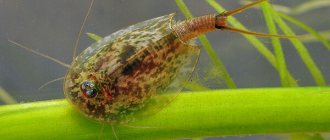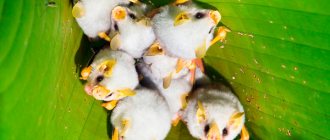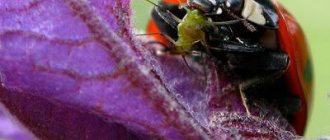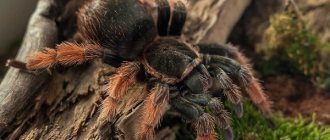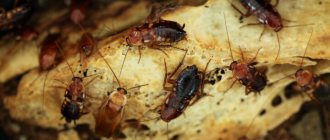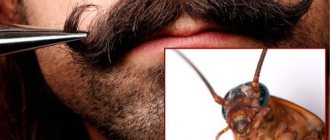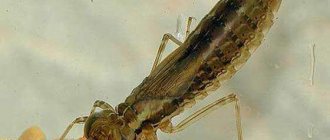Feeding of insects with chewing mouthparts
Gnawing mouthparts are characteristic of insects that feed on solid food: beetles, ants, locusts, cockroaches, grasshoppers, caterpillars and others. When examined under a microscope, they have a well-developed upper and lower lip, as well as a pair of upper and lower jaws. This allows them to easily cope with blades of grass, leaves, grains, seeds, fruits and even tree bark. The latter is eaten by many types of beetles and termites, because it is rich in nutrients and fiber.
Wood is the heaviest food for insects. To extract nutrition from it, they have to pass a lot of sawdust through their intestines.
Insect predators
Arachnida class
(Arachnida) has 35,000 species.
Arachnids include scorpions (Scorpiones), false scorpions (Pseudoscorpiones), telephons (Uropygi), salpugs (Solifugae), harvestmen (Opuliones), spiders (Arachineina) and ticks (Acarina). The vast majority of these animals are predators. Mites are plant pests (spider mites, gall mites, barn mites, etc.), some species cause or spread diseases of animals and humans, but there are also many beneficial species that feed on nematodes, eggs and larvae of various insects. In the soil and in the crevices of tree bark in gardens and forests, predatory mites of the family Bdellidae are often found, which destroy springtails and other small insects and mites, such as Bdella longicomis. There are many acariphages in the family Phytoseiidae. Thus, Kampimodromus aberrans destroys fruit mites. Very active acarophagous mites Amblyseius finlandicus, Paraseiulus soleiger. Farmers widely use the phytoseiulus mite to combat spider mites in greenhouses.
Dragonfly
(Odonatoptem) is the oldest insect. There are many different types of dragonflies. These insects
They fly during the day, most of them can be found near rivers and reservoirs, as well as in meadows and forest edges. They catch a lot of mosquitoes, midges, and small butterflies. Eggs are laid in water or on aquatic plants. The larvae live in water, feed on the larvae of mosquitoes and other aquatic insects, grabbing them with a modified lower lip - a mask, which folds when at rest.
Mantis
(Mantoptera) - an insect with gnawing type mouthparts, an elongated prothorax, and reticulate wings. A characteristic feature of the praying mantis is its grasping front legs. Insects are mostly green or brownish-yellow in color, while desert species are usually gray in color. Praying mantis larvae feed mainly on aphids, while adults feed on various insects (locusts, flies, small butterflies, etc.). Waiting for its prey, the praying mantis sits on plants in a characteristic position with its front legs raised up, with which it grabs insects that appear nearby. The common mantis (Mantis religiosa) is common in Ukraine, and the striped mantis (Empusa fasciata) is also common in Crimea. To attract the praying mantis, peas are planted in the area, because it lays eggs only on this plant.
Steppe grasshopper
(Saga pedo) is also a predator. It reaches 10 cm in length and is wingless. It feeds on locusts, bugs, and caterpillars. Distributed in the steppe zone.
Green grasshopper
(Tettigonia viridissima) is a “facultative” predator, distributed almost everywhere. It feeds on small butterflies, caterpillars and other insects, and sometimes damages plants.
Thrips
(Thysanoptera) are mostly phytophagous, but among them there are also 17 predatory species. Thus, Aeolothrips intermedins destroys harmful wheat, tobacco, rye, barren and flax thrips. One of its larvae sucks up to 90 eggs of wheat or 40 larvae of tobacco thrips during the day.
Scolothrips sixspotted
(Scolothrips sexmaculatus) lives on various plants infested with mites. This thrips destroys especially many blackthorn and brown fruit mites.
Bedbugs
can be pests of agricultural crops, but many families of the order of bugs contain entomophages, for example, Anthocoris nemorum L. Adult bedbugs overwinter in plant debris and cracks in tree bark. They emerge in late April - early May and feed on red fruit mite eggs, aphids, honey beetles - a total of 37 species of insects and mites. Females lay eggs (one at a time) in the parenchyma of leaves of apple trees and other crops on the upper side of the leaf for 2 months (60-100 eggs in total). Predatory beneficial bugs are most often found in fields located near deciduous forests, bushes, and parklands.
From the family of horsefly bugs (Miridae), the tick-borne horsefly terus angulatus is known as a beneficial species, which destroys fruit mites.
Several families of bedbugs consist of only predatory species. The family Reduviidae is called predators. Some of the predators live in fields, meadows or forests and destroy various insects. House predators (Ploearia domestica) hunt flies indoors at night.
Adults of the bugs Perillus bioculatus F. overwinter in plant debris, forest litter, and cracks in tree bark. After emerging from hibernation, males and females feed for some time on the juice of potato leaves, and then on eggs, larvae and adults of the Colorado potato beetle. After mating, the female lays a clutch of 14 eggs in two rows on the upper side of a potato leaf. The lemon-yellow eggs turn brownish-black over time. The female lives 10 months, mates every 14 days and lays an average of 160 eggs. The larva feeds on eggs and larvae of the Colorado potato beetle; during 3-4 weeks of its development, it eats at least 400 eggs and larvae.
The spotted bug (Podisus maculiventris) is a predatory insect from the order Hemiptera of the stink bug family (Pentatomidae), feeding on the larvae of many types of pests: American cotton bollworm (Heliotis zed), epilachna spp., tobacco leaf miner (Phthorimaea operculella) etc. Larvae and nymphs of the bug actively feed on eggs and larvae of the Colorado potato beetle, and to a lesser extent on adults. One entomophagous larva eats 140 eggs, 7-12 larvae and 1 beetle, while the imago eats up to 500 eggs, 50-60 larvae and up to 14 beetles.
Some do not distinguish Podius from the European bug (Eurygaster integriceps), but these are completely different bugs, although they belong to the same family of stink bugs.
Optimal conditions for the development of subsus: 25-28 ° C, air humidity 85%. In this case, the entire development cycle lasts 34 days. The average fertility of females is about 260 eggs. Bedbug eggs and larvae die when exposed to temperatures (more than 5 days) below 10 °C for a long time, so for practical purposes it is used mainly in the southern regions of the country. It is advisable to use it against the Colorado potato beetle when the first generation appears. At a bedbug release rate of 1:20, the efficiency reaches 85%. After fledging, the bugs usually fly away from the fields, which requires recolonization. In total, it is recommended to release entomophages 3 times during the growing season. There is no excess of insects, because the overwhelming number of individuals die in winter, as a result of the use of traditional agricultural technology on nightshade crops (peppers, eggplants, potatoes), spring and autumn tillage, and crop rotation.
The families of hunting bugs (Nabidae) and anthocoridae (Anthocoridae) also consist of only predators. They destroy eggs, small larvae and adults of various insects. Some of them are entomophages of the Colorado potato beetle (Himacerus apterus, Anthocorisnemorum, A.pilosus, Onusniger, O. majusculus, etc.).
Order Coleoptera
(Coleoptera) has more than 250,000 species and consists of 2 suborders - carnivores and heterovores. Carnivores include ground beetles (Carabidae).
A significant part of ground beetles do not fly, but they run quickly and climb trees. A large number of caterpillars are destroyed by ground beetles of the genus Calosoma. Thus, the great beauty destroys the hairy caterpillars of the gypsy moth and other silkworms, as well as the goldwing. One beetle eats more than ten caterpillars within a day. The small beetle (C. inquisitor) flies well, destroys various caterpillars in gardens and shelterbelts, and the steppe beetle (C. denticolle) - in the fields.
Rove beetles
, or short-winged beetles (Staphylinidae), differ from others by shortened elytra, which barely cover half of the abdomen. Rove beetles feed on various arthropods and nematodes. Thus, Oligota larvae and beetles suck out harmful spider mites. The species A. Pusillima is common. A very effective entomophage of cabbage and beet leaf miners is Aleochara bilineata.
Rodolia
(Rodolia cardinalis) is an insect from the order Coleoptera of the family Coccinellidae. A specialized predator, it feeds on the grooved bug (Iceria purchasi), a pest of citrus, fruit (olives, figs, apple, almond, apricot, feijoa) and other crops. The beetle was brought from Egypt. It overwinters well under plant debris in the imago and pupal stages. At the beginning of summer, rhodolia lays eggs (300-500 in total) on plants in places where scale insects accumulate. Larvae of the 1st instar destroy scale insect eggs, and older ones destroy scale insects at all other stages. After this, the larvae pupate on the underside of leaves and in the forks of branches.
The development cycle of rhodolia lasts 20-40 days, depending on weather conditions. During the growing season, 4 generations are usually formed. To suppress the grooved scale insect, 10-20 beetles are released per tree. A one-time infestation is often sufficient to control the development of the pest for several years (2-3 years).
Cryptolemus
(Cryptolaemus montrouzieri) is a medium-sized insect (3-4 mm) from the order Coleoptera of the ladybird family (Coccinelidae), the adult and larval stages of which feed on eggs, larvae and adults of mealybugs and cushion flies. One cryptolemus larva eats up to 4000-7000 eggs, 200-300 larvae or 40-60 adults during its life. The adult of Cryptolemus is black, the abdomen is red. Beetles live up to 12 months. The fertility of females is 200-500 eggs. The eggs are oval and yellow. The larvae are yellow-green, with waxy outgrowths. The development cycle under favorable conditions (temperature 20-26 °C, humidity 70-85%, daylight hours 18 hours) is 35-40 days. Over the course of a year, 3-4 generations develop in the southern regions.
The release rate of cryptolemus per 1 hectare is from 5,000 to 10,000 adults or 10,000 larvae, on fruit trees - 5-10 individuals / tree, on grapes - 3 individuals / plant. In this case, the effectiveness of the entomophage reaches 90-95%, and pest control will last 2-3 years.
Ladybug seven-spotted
(Coccinella septempunctata). The scientific name refers to the red coloration, and the insect is called a ladybug because of the yellowish liquid that the ladybug secretes when pressed on it.
In addition to the seven-spotted one, about 20 other species of ladybirds are found in gardens, which differ in the color of the elytra and the number of spots. Among local species, Adalia bipunctata, Coccinella septempunctata, nums spp., Stethoruspunctilum usually predominate in gardens, and in vegetable crops - Adonia variegata, Propileae quatuordecimpunctata, C. septempunctata, C. undecimpunctata.
The beetle overwinters under fallen leaves in forest belts, gardens, and under the bark of trees. In early spring, ladybugs mate and lay small piles of smooth yellow eggs among aphid colonies. Each female lays about 100 eggs. After 6-8 days, brightly colored larvae appear. They are very mobile, moving quickly in search of food. The diet consists mainly of aphids. Each larva eats 30-40 aphids per day, and 600-800 individuals in a lifetime. It also feeds on scale insects, small caterpillars, and other pests.
Adult larvae pupate in feeding areas and after 6-9 days beetles appear, which also actively feed on aphids. Development from the egg phase to the adult insect takes about a month. 1-2 generations develop per year. The number of ladybugs in gardens depends on the turf between the rows: on lupine there can be up to 3-4 individuals per 1 m2. After mowing the lupine, the insects move on to the fruit trees and reduce the number of aphids and copperheads by 80%. The number of ladybugs is also determined by the number of different species of aphids that inhabit field, vegetable and garden crops. In turn, the number of aphids depends on many factors, including weather conditions. If weather conditions favor aphid development, you should expect an increase in ladybird numbers both this year and next.
Common lacewing
(Chrysopa satea Steph). A delicate green or yellow-green insect with an elongated body and large mesh wings (up to 40 mm), convex shiny eyes.
Lacewings fly primarily at dusk and are attracted to light, especially yellow light. They overwinter in cracks in tree bark, indoors, in plant debris and in other hidden places. Lacewings leave their wintering grounds in the spring, when the air warms up to 10 °C. They feed on the nectar of early flowering plants and the sweet secretions of aphids, after which they begin oviposition. Each female lays 60 eggs per day, her total average productivity is 400 eggs. The eggs are held on separate “legs” so that the first larva to hatch cannot eat the rest.
When the larva descends along the “leg” onto the leaf, it finds easy prey - aphids. They feed on larvae, aphids and coccidia, but can also eat eggs of other pests. In total, during the larval stage, the lacewing eats about 600 aphids, and about 50 apple red mites per day. Development from larva to adult insect lasts 60 days. During the season, the lacewing produces 2-3 generations.
Afidomiza
(Aphidoletes aphidimyza) is a small insect from the order Diptera (Diptera) of the gall midge family (Cecidomyiidae). Widely distributed in natural conditions. It overwinters in the pupal phase on the soil surface under plant debris. Females fly out at the beginning of the growing season and lay eggs (from 50 to 140) among aphid colonies. The larvae feed on aphids, first paralyzing the victim with a toxin. One aphidomiza larva destroys 60 or more aphids. Under optimal conditions (temperature 25 °C, relative air humidity 70-90%), the development of one generation lasts 16-20 days.
When mass breeding of the entomophage, colonies of aphids (Megoura viciae or Aphis fabae) contained on broad bean plants are usually used. The larvae, having finished feeding, form cocoons, which are collected and laid out near aphid colonies in small containers (for example, peat pots) covered with paper on top. In practice, they also use the replanting of larvae directly into the aphid colony or the release of adults.
Scolopendraceae
(Scolopendromorpha) are exclusively predators. They are distributed mainly in tropical and subtropical zones. In Crimea, southern Ukraine and Russia, the ringed scolopendra (Scolopendra singulata) is often found. This is a large centipede, up to 10 cm long. She has poison glands. It is active at night, destroys many beetles, orthoptera, caterpillars gnawing on armyworms, etc. Centipedes of drupes (Lithobiomorpha) and scutigers (Scutigeromorpha) also lead a predatory lifestyle. They also feed on various insects at night. Sometimes found in houses (not found in apartments due to dry air), some call them flycatchers.
Common earwig
(Forficula auricularia L.) is another beneficial predator. An adult insect has a well-developed oral apparatus, the body ends with strong cerci, which serve for defense and attack. The earwig has 2 pairs of wings: the hind wings fold several times along (like a fan) and twice across. The compound hind wings are covered on top by small leathery fore wings.
The earwig develops like an insect with incomplete metamorphosis. Mating occurs in late summer and autumn. The female mates several times with different males. In autumn, it digs holes in the soil 5-15 cm deep and after the first frost climbs there together with one male. After spring mating, the female expels the male from the hole and lays 20-60 eggs, which she guards, covering her with her own body. Embryonic development lasts about 2 weeks. Some individuals lay eggs in the fall, then their development continues until spring.
The larvae emerging from the eggs are similar to adult insects, only they do not have wings. Until the second moult, the larvae are protected by the mother. Gradually, nest connections weaken, and the larvae that go out in search of food no longer return to the nest. Development lasts 5-6 months. During this time, the larvae molt 5 times, becoming more and more similar to adults.
Young earwigs lead a crepuscular lifestyle. During the day they hide under branches, boards, leaves lying on the ground, in crevices of tree bark. At dusk, they readily eat caterpillars, aphids, pupae, and eggs of various insects. Their hunting is especially successful in hunting belts, where they find shelter and feed on the larvae and pupae of codling moths and other insects.
Earwigs live near human habitation and can cause some harm during mass reproduction, gnawing young leaves and stems of vegetable crops, juicy fruits of strawberries, peaches, and apricots. But their mass reproduction is a very rare phenomenon.
Thaumatomy
(Thaumatomyia) is the main enemy of the beet aphid. The puparia of this fly overwinter in the soil at a depth of 10-30 cm. About 80% of predators overwinter normally. At the same time, puparia can withstand not only a long-term decrease in temperature to -17 °C, but also temperature changes from +5 °C to -17 °C. The flight of the fly begins in the second half of May and continues throughout the summer. The peak occurs at the beginning of June. Intense flight is observed on the vetch. The concentration of flies on this crop is due to the morphophysiological characteristics of the plant: on its stipules there are glands that produce sweet secretions that attract flies as additional food for the imago. At this time, flies lay eggs. The larvae, which subsequently emerge from them, live in the soil and destroy root aphids. That is why conditions for development and reproduction can be created for this insect near beet plantations by sowing vetch.
Hover flies
, or syrphidae (Syrphidae), are insects similar to hornets; in the summer they can be seen on the flowers of dill and carrots.
Adult syrphids feed on the nectar of small-flowered plants, and the larvae feed on aphids, spider mites and other pests. After mating, the female lays up to 200 eggs, and syrphid eggs are laid where there are a lot of aphids. After 2-4 days, yellowish or greenish legless larvae hatch and feed on aphids. The larva moves, pouring the contents of its body from the tail end to the head end, and vice versa.
The development of the larva lasts 2-3 weeks. The older the larva is, the greater its appetite. An adult larva can eat about 200 aphids per day, and over the entire period of development - up to 2000. The larva completes its development in the form of a puparia, which looks like a drop of resin. After 1-2 weeks, an adult insect emerges from the puparia, rests for a couple of hours, spreads its wings, and then sets off into adulthood. During the season, some species have 1-2 generations, and some have up to 4.
Syrphid is launched into greenhouses to suppress various types of aphids that harm vegetable and ornamental crops. The technology for their breeding has already been mastered for such species as Syrphus corollae, S. balteatus, S. ribesii. Syrphids are light-loving insects. Depending on housing conditions, females can lay from 60 to 250 eggs. For example, at 420 lux the number of eggs is 7 times greater (more than 200) than at 174 lux. The fertility of females is also affected by the density of pests (aphids) on plants, because eggs are placed in their colonies. The optimal temperature for the development of syrphid is 20-25 ° C, relative air humidity is 70-95%. Under such conditions, the duration of development in different species varies from 16 to 23 days. Female syrphids have specific species preferences; for example, the syrphid lunate preferentially lays eggs in colonies of cabbage aphids (Brevicoryne brassicae).
If you find an error, please select a piece of text and press Ctrl+Enter.
Feeding of insects with sucking mouthparts
Prominent representatives of insects with a sucking apparatus are butterflies. To enjoy the sweet nectar of a flower, they just need to lower their long and thin proboscis inside it. In evolutionary terms, the proboscis is nothing more than elongated jaws fused at the edges. In the normal state, the proboscis of butterflies is curled into a tight spring. This type of mouthparts is also characteristic of most species of flies and some beetles.
The length of the proboscis of butterflies varies greatly. In Madagascar Macrosila predicta, for example, the proboscis exceeds 25 cm.
Mantis
The praying mantis (mantis religiosa) is an insect common in Asia, Europe, Africa and some areas of North America. It measures approximately 5 centimeters and is characterized by large eyes and two elongated front legs. The praying mantis usually feeds on other insects, but can also prey on frogs, small birds, lizards and rodents...
The praying mantis laughed : females usually devour the male after mating.
Feeding of insects with piercing-sucking and licking-gnawing mouthparts
The piercing-sucking mouth can be seen in mosquitoes, some flies, wasps, bedbugs and many other types of insects. Using such a device, they pierce the skin of plants or living creatures and feed on their juice or blood. A horsefly, for example, has a whole set of piercing objects in its mouth, because in order to get to the animal’s blood, it needs to pierce its thick skin.
The licking-gnawing oral apparatus allows the insect to gnaw solid food with the upper jaws and at the same time suck in liquid food using the proboscis formed by the lower jaw and lip. Prominent representatives of insects with such a mouth are bees, which not only lick honey and pollen, but also knead wax.
How the bee-eater catches prey
Bee-eater on the hunt
The Nubian, or purple, bee-eater is a bird from the genus of bee-eaters, or bee-eaters. The length of an adult bird reaches 36-39 cm. This beautiful bird lives in Africa. And she hunts grasshoppers, bees, cicadas and ants. The bee-eater is not afraid of fires in the savannah - after all, then thousands of insects, escaping from the fire, fly up from the grass, and it is not difficult for the bird to catch them for dinner. And in quiet times, the bee-eater can often be seen sitting on the back of an antelope or some large bird, such as an ostrich or bustard. The fact is that when walking, these animals scare away insects, which the bee-eater immediately grabs.
The grasshopper is quite an easy prey for this bird
Birds
Surprisingly, birds love to eat cockroaches. Crows, sparrows, and domestic chickens will enjoy eating protein meat.
Songbirds living at home (robins, nightingales) do not refuse the marbled appearance and eat it.
Some owners have learned not to buy expensive food, but to grow it at home inside containers.
Cabbage pests
The juicy large leaves of this vegetable are preferred by many parasites. What insect eats cabbage? It could be an aphid, cabbage moth or white butterfly caterpillar. Perhaps there are fleas in the ground or the plant is being affected by the cabbage cutworm.
Pests thrive and successfully reproduce during periods of prolonged heavy rains, when the ground does not dry out for a long time. This weather most often occurs in June and early July. It is necessary to fight against harmful cabbage lovers.
We suggest you familiarize yourself with: Spider is an insect or arthropod
Plant pests
What insects eat plants is difficult to answer without thinking. After all, plant foods are in the diet of almost all animals, including insects. There are many of them, it is impossible to list them all. Here are some of them:
- The Colorado potato beetle is a malicious pest that prefers to harm tomatoes, peppers, potatoes and other nightshade crops. It's easy to recognize. The body has a round oval convex shape with black longitudinal stripes. The beetles overwinter in the ground and, with the onset of autumn, actively attack young seedlings.
- The cruciferous flea beetle is very dangerous for vegetables from the family of the same name, which includes cabbage, katran, radish, lettuce, and rutabaga. The insect is not averse to eating horseradish and mustard greens. This small bug with a body length of only three millimeters is able to withstand frost, hiding under plants that have not been harvested from the garden. With the onset of spring, the flea flea comes to life. It gets into the soil with seedlings. It lays larvae within a couple of days. As they develop, they begin to harm the roots. Adults chew through the leaves, leaving sores on them. They quickly wither and begin to die. The flea breeds intensively in warm, dry weather.
Pets
When red or black cockroaches appear in an apartment, you can notice how dogs or cats begin to hunt for them. Most do it for fun, pleasure, and bring it to show the owner.
But scientists say that cats love these insects, chitin is useful for them, especially after surgery (castration, sterilization).
Who else is eating:
- If there is a lizard living at home, you can let it out for a walk; it also feeds on domestic cockroaches.
- Spiders that live in every house hunt for insects. They weave a web and wait for one of them to fall into the net. The spider releases its poison with acid inside the body, which paralyzes and digests the insides, which later becomes an excellent meal. A dried cockroach from the inside becomes a bait for its other relatives.
- The domestic hedgehog also feeds on small insects. He hunts for them in corners and catches colonies.
As you can see, the list of those who like to eat unpleasant insects is quite extensive. Therefore, at home you can successfully fight them; to do this, it is enough to have pets.
Lifestyle of aphids
The insect aphid prefers to live in large colonies. Its favorite habitats are on green leaves and young shoots. Ants become companions throughout their lives. This tandem benefits both of them. The aphid is under the reliable protection of the ant, which feeds on its honeydew.
It's interesting to watch their interactions. The ant approaches the aphid and, after gentle tickling, receives a portion of the sweet liquid. This droplet is transmitted along a chain to the ant’s house, where aphids often find refuge in the winter. Aphids have enemies from which the ant tries to carefully protect them. Ladybugs and lacewings can destroy aphid colonies.
Crickets
Crickets live in burrows. To get a cricket, fill its hole with water and it will come out on its own. We catch it, and then fry it, even boil it, or even bake it over the fire.
You should not eat locusts, grasshoppers and crickets raw because, as a rule, these insects are infected with parasites.
Bon Appetit. And don’t forget to share the link on social networks, this will help the development of the site. Thank you!!!
What insects can be eaten in extreme conditions?
Bullet Ant
What insects eat insects? These are Red Ants. Their poison is comparable to fire in terms of impact. This is where the insects got their name. They are also called Fiery. A person stung by this ant feels nausea, dizziness, vomiting, redness, swelling and blisters on the skin. Some experience anaphylactic shock.
What insects eat insects? These are Fire Ants - aggressive predators. Thanks to their efforts, many pests of gardens, fields and vegetable gardens are always under control. First of all, locusts, which are gregarious insects. Agricultural lands are suffering from various types of locusts. But the desert one is considered the most voracious, which is why it is also the most dangerous for plants.
What insects eat insects? One of them is the bullet ant. It should be feared because of its strong bite, which resembles a wound. Hence the name of the insect. This ant is small, only two and a half centimeters in length. He makes his home in the trees. Before the attack, it screams shrilly, and then falls from a height onto its victim. The pain of its bite is reminiscent of walking on burning coals with a nail in the heel.
The indigenous population of some countries even today uses the insect for ritual actions, for example, initiation into adulthood. The birthday boy is given a cape made of leaves, which is infested with ants woven into the sleeves. When he sticks his hands into them, he receives numerous bites, from which his hands become stiff and curled. The body has been shaking with uncontrollable spasms for several days. The goal of the ritual is to hold out for at least ten minutes.
We suggest you read: How to treat a bed for fleas
Several species of ants are a highly prized delicacy. Lemon ants (Myrmelachista schumanni) from the Amazon jungle are said to have a distinctive lemon aroma. Leafcutter ants are usually fried and are said to taste similar to bacon or pistachio nuts. Honey ants are eaten raw and taste sweet. In Western society, ants from the genus Camponotus are considered the most edible.
Adult ants, their larvae and eggs can serve as a source of food for humans. Ant eggs are considered a special form of insect caviar and have a high price. Insects are eaten raw (even alive), fried, boiled, crushed and as an additive to drinks.
Wasps and bees are also edible for humans, and are in the same order as ants.
In nature
The cockroach is not the main food for any animal; rather, it is a favorite delicacy, a delicacy eaten with pleasure. In nature, there are natural enemies that hunt them.
The peculiarity of these insects is their excellent survival rate. This is a practically endangered type of food; it is not afraid of changes in high and low temperatures, high humidity, drought, and radioactive radiation.
If a nuclear war occurs, cockroaches will remain alive, serving other animals and people as a source of food.
